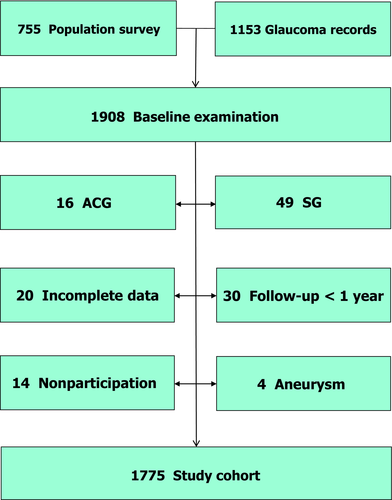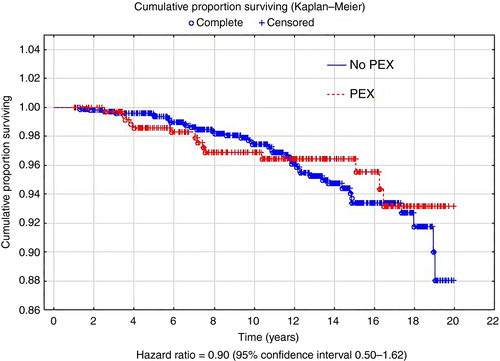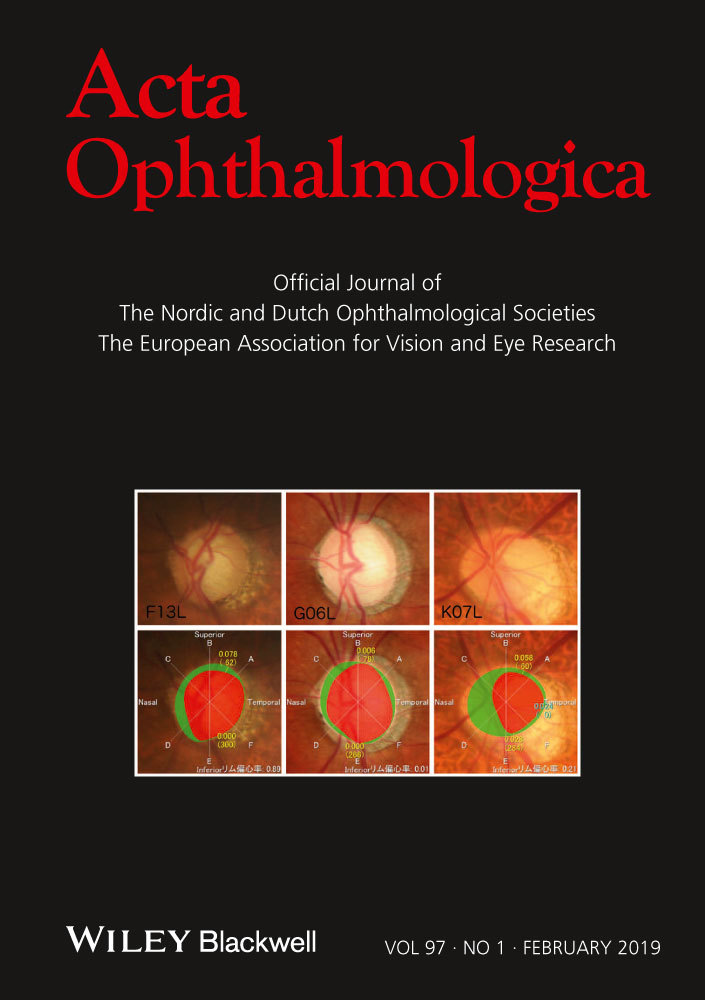Pseudoexfoliation and aortic aneurysm: a long-term follow-up study
Abstract
Purpose
To study the relationship between pseudoexfoliation (PEX) and aortic aneurysm in a population with a high prevalence of PEX.
Methods
Survival analyses were performed in a cohort of 735 residents aged 65–74 years, examined in a population survey in the municipality of Tierp, Sweden, 1984–1986. To expand the sample size, 1040 people were recruited by means of glaucoma case records established at the Eye Department in Tierp in 1978–2007. In this way, the cohort comprised 1775 subjects, representing more than 25 400 person-years at risk. Medical records and autopsy reports were reviewed to identify subjects diagnosed with aneurysm. Those with a follow-up time shorter than 1 year were excluded.
Results
By the end of the study in September 2017, 60 new cases of aortic aneurysm had been found. Of these cases, 23% (14 subjects) were affected by PEX at baseline, compared with 28% among subjects without aneurysm. No association between PEX and aortic aneurysm was found (hazard ratio 0.97; 95% confidence interval 0.53–1.77).
Conclusion
In this population-based study, we were unable to verify a relationship between PEX and the development of aortic aneurysm.
Introduction
Pseudoexfoliation (PEX) is an age-related disorder, characterized by the production and accumulation of a fibrillar extracellular material in the anterior segment of the eye (Ritch & Schlötzer-Schrehardt 2001). Common sequence variants in the lysyl oxidase-like 1 gene, involved in elastic fibre formation, are closely associated with PEX (Thorleifsson et al. 2007). In a previous report from Tierp (Ekström 1993), PEX was identified as an independent risk factor for the development of open-angle glaucoma. Furthermore, PEX proved to be a predictor for cataract surgery (Ekström & Botling Taube 2015). Other than in the eye, PEX fibres have been found in blood vessels, skin, gall bladder, kidneys, lungs, heart and meninges (Schlötzer-Schrehardt & Naumann 2006).
In view of the systemic occurrence of PEX fibres, studies have been undertaken to examine a possible connection between PEX and vascular disease. In fact, an increased frequency of cardiovascular incidents in people exposed to PEX has been reported (Mitchell et al. 1997; Naumann et al. 1998; Schumacher et al. 2001; French et al. 2012). Subjects with PEX have also been found to have increased levels of homocysteine in plasma, a well-known risk factor for cardiovascular disease (Xu et al. 2012). Other studies have failed to demonstrate any association with systemic vascular diseases (Hietanen et al. 2002; Tarkkanen et al. 2008; Špečkauskas et al. 2012; You et al. 2013). Recently, a large-scaled meta-analysis revealed a possible connection between PEX and vascular disease (Wang et al. 2014). In this review, PEX was associated with a 2.48-fold increased risk for aortic aneurysm. However, even if PEX increases the risk of vascular events, it does not seem to have any impact on all-cause mortality (Ringvold et al. 1997; Grødum et al. 2004; Svensson & Ekström 2015).
The purpose of this investigation was to study the relationship between PEX and aortic aneurysm in a cohort embracing a substantial number of exposed individuals. A strong connection between the disorders would raise the awareness of a possible aneurysm in the presence of PEX. The investigation took the form of a population-based long-term follow-up study.
Materials and Methods
The Tierp glaucoma survey
In 1984–1986, a population survey was conducted in the municipality of Tierp, south central Sweden. Its target population comprised 2429 residents who were 65–74 years of age. The size of the sample was limited to about one-third of the target population. Of the eligible number of 838 residents, 760 underwent a detailed eye examination, as described elsewhere (Ekström 1996). Briefly, an interview was held, covering medical and family history. Information was also obtained from medical records. After perimetry, the pupils were dilated and slit-lamp biomicroscopy undertaken. Pseudoexfoliation (PEX) was defined as the presence of characteristic white flakes on the lens capsule or on the pupillary border.
The cohort
A total of 78 people did not participate in the population survey. Of these, one joined the cohort after being examined in 1993. Six subjects, not examined in Tierp, were defined as ineligible for the study. Thus, this part of the cohort comprised 755 subjects. To expand the sample size, 1153 people, 414 of whom had a diagnosis of open-angle glaucoma, were recruited by means of glaucoma case records established at the Eye Department in Tierp in 1978–2007. Those enrolled were in the age range 65–74 years, residents of the municipalities of Tierp or Älvkarleby, Uppsala County. Apart from visual field testing, they underwent an eye examination comparable with that of the population survey.
Of the total number of 1908 individuals, 65 were diagnosed with either angle-closure glaucoma or secondary glaucoma. They were excluded from the study, as were 20 subjects with incomplete data and 30 with a follow-up time shorter than 1 year. Four subjects with a history of aortic aneurysm were also excluded (Fig. 1). Fourteen people did not want to take part in the study. The remaining 1775 constituted the study cohort, whose characteristics are presented in Table 1. The Regional Ethical Review Board of Uppsala University approved the study. The tenets of the Declaration of Helsinki were observed.

| Age group (years) | No. of people (n = 1775) | Person–years (n = 25 417) | ||
|---|---|---|---|---|
| Female (%) | Male (%) | Female (%) | Male (%) | |
| 65–69 | 550 (54) | 399 (52) | 9344 (60) | 5714 (59) |
| 70–74 | 460 (46) | 366 (48) | 6348 (40) | 4011 (41) |
| 65–74 | 1010 (100) | 765 (100) | 15 692 (100) | 9725 (100) |
- Mean follow-up time: 14.3 years (standard deviation: 7.1).
Collection of data
Occurrence of PEX was determined from screening protocols or glaucoma case records. Subjects with PEX in either eye at baseline were defined as exposed to PEX. Anamnestic information on medical history and smoking habits was collected from study protocols or medical records. As a rule, diagnoses found in medical records were accepted. Follow-up started at the first examination in Tierp and ended on 1 September 2017. Death dates were obtained from the local population register (Masterbef) held by Uppsala County Council.
Assessment of aneurysm
Medical records and autopsy protocols were reviewed to identify subjects diagnosed with aneurysms of the abdominal or thoracic aorta. Diagnoses were based on ultrasound examination, computed tomography, magnetic resonance tomography or findings at autopsy. An aortic aneurysm was defined as a maximal aortic diameter ≥50% of the normal adjacent segment or ≥3 cm (Johnston et al. 1991). A specialist in vascular surgery (AW), ‘masked’ to baseline data, approved the diagnoses, using all available information. Mean follow-up time was 14.3 years (standard deviation 7.1).
Statistical methods
Gender-standardized morbidity ratios (SMRs) were estimated. Follow-up time was calculated from baseline to date of aneurysm diagnosis (n = 60), date of death (n = 1408), date of migration out of Uppsala county (n = 66), or end of the study (n = 241), whichever occurred first. Following standardized analyses, Cox proportional hazards models were developed to assess the effect of more than one predictor. The proportionality assumption was tested using time-dependent variables. The effect of the covariates on survival was independent of time.
Results
By the end of the study, 60 individuals or 3.4% of the study cohort were diagnosed with aortic aneurysm. Of these cases, 23% (14 subjects) were affected by PEX at baseline, compared with 28% among subjects without aneurysm. Forty-six aneurysms were found in the abdominal and 14 in the thoracic aorta. At least 11 aneurysms were lethal. Table 2 provides SMRs for aneurysm. Male gender, smoking, hypertension and ischaemic heart disease were associated with aneurysm, while age was not. Pseudoexfoliation (PEX) did not increase the risk [SMR 0.90; 95% confidence interval (CI) 0.49–1.64]. Kaplan–Meier curves for the first 20 years are presented in Fig. 2.
| Baseline characteristics | No. of cases (n = 60) | SMR (95% CI) |
|---|---|---|
| Age ≥70 years | ||
| No | 35 | 1.00 |
| Yes | 25 | 1.03 (0.62–1.72) |
| Male gendera | ||
| No | 20 | 1.00 |
| Yes | 40 | 3.23 (1.89–5.52) |
| Pseudoexfoliation, either eye | ||
| No | 46 | 1.00 |
| Yes | 14 | 0.90 (0.49−1.64) |
| Current smoker | ||
| No | 35 | 1.00 |
| Yes | 25 | 3.53 (2.08−6.00) |
| Hypertension, treated | ||
| No | 35 | 1.00 |
| Yes | 25 | 1.66 (0.99−2.79) |
| Ischaemic heart disease | ||
| No | 45 | 1.00 |
| Yes | 15 | 1.81 (1.01−3.26) |
- CI = confidence interval; SMR = standardized morbidity ratio.
- a Adjusted for age.

Cox proportional hazards models included PEX, age, gender, current smoking, hypertension, ischaemic heart disease, year of birth and participation in the population survey. The final model is presented in Table 3. Pseudoexfoliation (PEX) was not associated with aneurysm (hazard ratio: 0.97; 95% CI: 0.53–1.77). There was no indication of interaction between the covariates. Adjustment for birth year or participation in the population survey had no effect on the estimates (data not shown).
| Covariate | No. of cases (n = 60) | HR (95% CI) | p-value |
|---|---|---|---|
| Pseudoexfoliation, either eye | |||
| No | 46 | 1.00 | 0.917 |
| Yes | 14 | 0.97 (0.53–1.77) | |
| Male gender | |||
| No | 20 | 1.00 | 0.001 |
| Yes | 40 | 2.68 (1.52–4.72) | |
| Current smoking | |||
| No | 35 | 1.00 | 0.000 |
| Yes | 25 | 4.58 (2.68–7.83) | |
| Hypertension, treated | |||
| No | 35 | 1.00 | 0.047 |
| Yes | 25 | 1.72 (1.01–2.94) | |
| Ischaemic heart disease | |||
| No | 45 | 1.00 | 0.029 |
| Yes | 15 | 1.96 (1.07–3.57) | |
- CI = confidence interval, HR = hazard ratio.
Discussion
Spanning over 30 years, this study on a defined population is the longest follow-up study on PEX and vascular diseases yet to be reported. Contrary to the results presented in the meta-analyses by Wang et al. (2014), PEX was found not to increase the risk of aortic aneurysm. However, although we had access to a sizeable cohort, only 60 cases were found, limiting the statistical power. In fact, with a confidence level of 95% and a power of 80%, the risk had to be more than twofold increased to be possible to detect.
Aortic aneurysm is a common disease among elderly men and a common cause of death in Western countries. The prognosis following rupture is poor. High age, male gender, smoking, ischaemic heart disease, hypertension, hyperlipidaemia and a positive family history are well-known risk factors for abdominal aneurysm (Golledge et al. 2006). Five of these risk factors were investigated in this study, and four of them were confirmed. Most important, current smoking was associated with an almost fivefold increased risk. Considering the significance of aortic aneurysm, it is a worthwhile task to increase our knowledge of the disease and its risk factors.
Our study has several strengths, including its population-based design, long-term follow-up and sizeable cohort, nearly half of which was randomly selected. The study is based on unbiased data measured at baseline before disease diagnosis. Thus, data on PEX were obtained from either screening protocols or glaucoma case records and information on aneurysm from medical records or autopsy protocols. Almost all the diagnoses of PEX were made by the same glaucoma specialist. An observer, ‘masked’ to baseline information, approved the diagnoses of aneurysm. Nevertheless, the study is limited in several respects, including its restricted statistical power.
First, baseline examination dates extended over nearly 30 years, which might give rise to bias. However, adjustment for year of birth in the regression models did not change the estimates. Secondly, an unknown number of people in the cohort with asymptomatic aneurysm were likely to have remained undiagnosed. Apart from widening the confidence limits, this type of information bias has no effect on risk ratio estimates, if the misclassification is equal for exposed and unexposed subjects (Rothman 1986). Thirdly, competing risks are a potential threat to studies analysing time-to-event data. In this study, the effect of PEX was equal across the competing events (death and aneurysm), while the effect of the other covariates was different. Unfortunately, owing to the sparse number of exposed cases, adjusting for competing events is not helpful.
To sum up, this cohort study in Tierp examined the association between PEX and aortic aneurysm over a 30-year period. Pseudoexfoliation (PEX) proved not to be related to the development of aneurysm. Thus, we were unable to verify the association reported in some previous studies.




